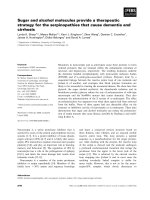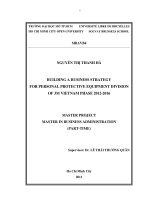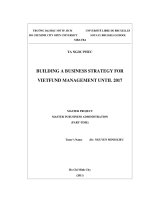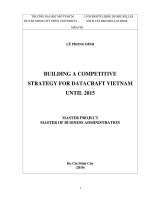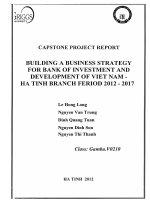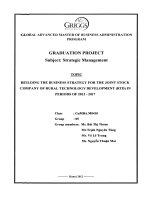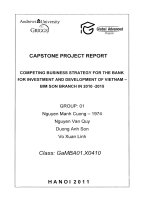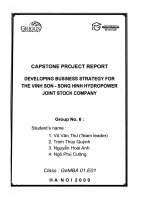Building a business strategy for the retail consulting division of vietmai solutions
Bạn đang xem bản rút gọn của tài liệu. Xem và tải ngay bản đầy đủ của tài liệu tại đây (987.34 KB, 91 trang )
i
ii
SUPERVISOR’S APPROVAL
I hereby certify that this dissertation, submitted by Mr. Tran Quoc Viet, conforms to acceptable standards and is fully adequate in scope and quality to fulfill the dissertation requirements
for the degree of Master of Business Administration.
_____________________________________________
________________
Dr. Bui Thanh Trang
Date
Supervisor
iii
ACKNOWLEDGMENT
Firstly, my deepest thanks to my supervisor, Dr. Bui Thanh Trang, for guiding and commenting on various document versions of mine with attention and care.
Secondly, I would like to thank Mr. Tran Thanh Tung, CEO of Vietnam Market Intelligence
Co., Ltd for giving useful remarks about the study’s quantitative questionnaire and guidelines
during the execution of the study’s survey; Mr. Le Phong Dinh and Mrs. Bui Thi Hong Hai ậ
my classmates ậ for reviewing my thesis and proposing corrections.
Thirdly, thanks also my staff at VIETMAI Solutions, especially Mr. Pham Quang Vinh, Mr.
Nguyen Manh Tuong and Mrs. Nguyen Ngoc Suong for helping me interview retailers and
synthesize survey’s results.
Last but not least, I would like to take this opportunity to express my deep gratitude and acknowledgement towards my family, especially my mom, my dad and my grand-mother for
being a constant source of love and moral support.
iv
EXECUTIVE SUMMARY
VIETMAI Solutions is an information technology company established and operating since
2006 with two main business areas, which are hardware reseller and software development.
The company's customers are mainly domestic customers and some are outsourcing oversea
customers. Activities of these two businesses in recent years have become stable and achieved
high growth rates. In 2009 and in 2010 the company achieved the ROE growth rates of 14.7
percent and 21.5 percent.
Beginning in 2010, recognizing the great potential of Vietnam's retail market, the company
opened a new business area. This business is retail consulting, starting with a POS software
and an inventory management software to support retailers. In 2010, though there were only
two contracts with modest values, the business still showed a very positive signal for the future development.
In the business plan for the period 2011 - 2015, the company aims to penetrate stronger into
the market. To achieve this goal, the company needs to examine, analyze the market in details
to develop an effective business strategy, and this is why the study is about.
The primary objective of the study is to analyze the external environment (markets, customers, products, competitors...) and the internal environment of the company to develop an appropriate business strategy for the retail consulting division. The secondary objective of the
study is to provide recommendations for revising the company’s corporate strategy based on
findings from the analysis.
The study begins with an in-depth analysis of the external environment (including the macro
environment, the Vietnam's retail market, the technology solutions market for retailers, customers and competitors) to identify opportunities and threats. After analyzing, the study continues with an overview of current operational status and performance of the company. Intensive internal environmental audits are carried out to identify strengths and weaknesses of the
company. Based on the analysis of the current situation, the study provides recommendations
for revising the company’s mission and long-term objectives. Alternative business strategies
are evaluated to choose an appropriate strategy for the retail consulting division.
v
Research results show that the market of technology solutions for retailers is really a potential
and attractive market. To penetrate this market, the company needs to focus on completing the
current POS software and inventory management software in the direction of a differentiation
strategy, and enhance marketing and sales activities to penetrate the market. Target customers
of the company are FMCG and fashion retailers because these customers are much more in
needs of value creation solutions from the company.
Although this study only focused on the retail consulting division, the way the research is
conducted and the results achieved will be a good basis for the company to carry out similar
studies for other divisions in the future. The study still has some limitations such as restrictions on data collection, detailed information about competitors. However, the influence of
these limitations to the results of the study was not high and can be eliminated when the company has more information during the strategy implementation process.
vi
TABLE OF CONTENT
TABLE OF CONTENT ...................................................................................................................................... VI
LIST OF FIGURES ..........................................................................................................................................VIII
LIST OF TABLES............................................................................................................................................... IX
LIST OF ABBREVIATIONS .............................................................................................................................. X
1.
CHAPTER 1 INTRODUCTION .............................................................................................................. 11
1.1. Rationale of the study ............................................................................................... 11
1.2. Problem statement .................................................................................................... 11
1.3. Objectives ................................................................................................................. 12
1.4. Methodology............................................................................................................. 12
1.4.1.
Research methodology ...................................................................................... 12
1.4.2.
Conceptual framework of the study .................................................................. 12
1.5. Scope, assumptions and limitations .......................................................................... 13
1.6. Structure of the study................................................................................................ 14
2.
CHAPTER 2 LITERATURE REVIEW ................................................................................................. 15
2.1. Strategy ..................................................................................................................... 15
2.2. Strategic management............................................................................................... 16
2.3. Strategic analysis tools ............................................................................................. 17
2.3.1.
SWOT analysis.................................................................................................. 17
2.3.2.
PEST analysis ................................................................................................... 18
2.3.3.
Porter’s five forces ........................................................................................... 19
2.3.4.
Value chain analysis ......................................................................................... 21
2.4. Porter’s generic strategies......................................................................................... 22
2.4.1.
Cost leadership ................................................................................................. 23
2.4.2.
Differentiation .................................................................................................. 24
2.4.3.
Focus ................................................................................................................ 24
3.
CHAPTER 3 EXTERNAL ANALYSIS .................................................................................................. 25
3.1. Environmental analysis ............................................................................................ 25
3.1.1.
Political, governmental, and legal factors ....................................................... 25
3.1.2.
Economic factors .............................................................................................. 26
3.1.3.
Social, cultural, demographic and environmental factors ............................... 29
3.1.4.
Technological factors ....................................................................................... 30
3.2. Retail sector in Vietnam ........................................................................................... 30
3.2.1.
High potential ................................................................................................... 30
3.2.2.
Foreign retailers ............................................................................................... 31
3.2.3.
Challenges for domestic retailers ..................................................................... 32
3.2.4.
Trends ............................................................................................................... 32
3.3. The market of technology solutions for retail sector ................................................ 33
3.3.1.
Products and services ....................................................................................... 33
3.3.2.
Define the market.............................................................................................. 34
3.3.3.
Market attractiveness ....................................................................................... 35
3.4. Customer analysis ..................................................................................................... 37
3.4.1.
Research design ................................................................................................ 37
3.4.2.
Findings ............................................................................................................ 39
3.5. Competitor analysis .................................................................................................. 47
3.6. Summary of opportunities and threats ...................................................................... 48
vii
4.
CHAPTER 4 INTERNAL ANALYSIS ................................................................................................... 50
4.1. Company overview ................................................................................................... 50
4.1.1.
Overview ........................................................................................................... 50
4.1.2.
Vision and mission ............................................................................................ 50
4.1.3.
Products and services ....................................................................................... 51
4.1.4.
Target market ................................................................................................... 51
4.1.5.
Organizational structure .................................................................................. 51
4.1.6.
Business performance ....................................................................................... 52
4.2. Corporate level analysis............................................................................................ 53
4.2.2.
Marketing audit ................................................................................................ 56
4.2.3.
Finance / accounting audit ............................................................................... 58
4.2.4.
Production / operations audit ........................................................................... 59
4.2.5.
Research & development audit ......................................................................... 62
4.2.6.
Management information systems audit ........................................................... 63
4.3. Specific analysis for the retail consulting business .................................................. 63
4.3.1.
The team ........................................................................................................... 63
4.3.2.
Products ............................................................................................................ 64
4.3.3.
Pricing .............................................................................................................. 64
4.3.4.
Marketing and sales ......................................................................................... 64
4.4. Summary of strengths and weaknesses .................................................................... 64
5.
CHAPTER 5 STRATEGY FORMULATION ....................................................................................... 66
5.1. Revising corporate strategy ...................................................................................... 66
5.1.1.
Redefining mission statement ........................................................................... 66
5.1.2.
Redefining and prioritizing long-term objectives ............................................. 66
5.2. Business strategy for the retail consulting division .................................................. 68
5.2.1.
Mission and objectives ..................................................................................... 68
5.2.2.
Key success factors ........................................................................................... 69
5.2.3.
Strategic directions ........................................................................................... 69
5.2.4.
Product strategy ............................................................................................... 70
5.2.5.
Marketing strategy............................................................................................ 74
6.
CHAPTER 6 CONCLUSIONS AND RECOMMENDATIONS ........................................................... 75
6.1. Conclusions .............................................................................................................. 75
6.2. Recommendations .................................................................................................... 76
6.2.1.
Leadership ........................................................................................................ 76
6.2.2.
Structural design .............................................................................................. 77
6.2.3.
Performance management ................................................................................ 77
6.2.4.
Information systems .......................................................................................... 78
6.2.5.
Human resources .............................................................................................. 78
6.2.6.
Finance ............................................................................................................. 79
6.2.7.
Linkage ............................................................................................................. 79
6.2.8.
External alliances ............................................................................................. 80
APPENDIX 1 QUESTIONNAIRE (ENGLISH VERSION) .......................................................................... XII
APPENDIX 2 QUESTIONNAIRE (VIETNAMESE VERSION) ................................................................ XVI
BIBLIOGRAPHY ............................................................................................................................................. XX
viii
LIST OF FIGURES
Figure 1.4-1. Conceptual framework of the study .................................................................... 12
Figure 2.2-1. Strategic decision making process ...................................................................... 16
Figure 2.3-1. PEST analysis ..................................................................................................... 18
Figure 2.3-2. Porter's five forces diagram ................................................................................ 19
Figure 2.3-3. Value chain analysis ........................................................................................... 21
Figure 2.4-1. Porter's generic strategies ................................................................................... 22
Figure 3.3-1. Retail functionality ............................................................................................. 33
Figure 3.4-1. Sample distribution ............................................................................................. 37
Figure 3.4-2. Responses for the “inventory management” operation....................................... 39
Figure 3.4-3. Responses for the “touch-screen” operation ....................................................... 40
Figure 3.4-4. Responses for the “scanners and barcodes” operation ....................................... 40
Figure 3.4-5. Responses for the “invoice printing” operation .................................................. 40
Figure 3.4-6. Responses for the “daily sales management and reporting” operation ............... 41
Figure 3.4-7. Responses for the “monthly sales management and reporting” operation ......... 41
Figure 3.4-8. FMCG stores’ responses for the importance of retail operations ....................... 42
Figure 3.4-9. Fashion stores’ responses for the importance of retail operations ...................... 42
Figure 3.4-10. F&B stores’ responses for the importance of retail operations ........................ 43
Figure 3.4-11. Responses for the uses of softwares to modernize stores ................................. 43
Figure 3.4-12. Reasons to use technology (for those already used technology) ...................... 44
Figure 3.4-13. Reasons not using technology (for those not using technology) ...................... 44
Figure 3.4-14. Purchasing criteria of retailers .......................................................................... 45
Figure 3.4-15. Factors that most impact purchase decision ..................................................... 45
Figure 3.4-16. Timing plan to modernize stores ...................................................................... 46
Figure 3.4-17. Maximum acceptable investment levels ........................................................... 46
Figure 4.2-1. Basic process flow of the hardware reseller division ......................................... 59
Figure 4.2-2. Basic process flow of the software development division .................................. 60
Figure 4.2-3. Basic process flow of the consulting division .................................................... 60
Figure 5.2-1. Retail value chain................................................................................................ 71
Figure 5.2-2. Value chain of retail consulting division and potential sources of uniqueness .. 72
Figure 6.2-1. New organizational structure .............................................................................. 77
ix
LIST OF TABLES
Table 2.3-1. SWOT analysis .................................................................................................... 17
Table 3.1-1. Per capita income (unit: USD / year) ................................................................... 28
Table 3.1-2. Consumer income and spending of Vietnam (unit: million USD) ....................... 28
Table 3.1-3. Unemployment rates ............................................................................................ 29
Table 3.2-1. Retail sales of Vietnam (unit: billion USD) ......................................................... 31
Table 3.5-1. Competitors classified based on product approach .............................................. 47
Table 4.1-1. Business performance by years (unit: million VND) ........................................... 52
Table 4.1-2. Detailed net revenue structure (unit: million VND) ............................................ 53
x
LIST OF ABBREVIATIONS
CIO
Chief Information Officer
CRM
Customer relationship management
CTO
Chief Technical Officer
ERP
Enterprise resource planning
F&B
Food and beverage
FMCG
Fast moving consumer goods
FDI
Foreign direct investment
GSO
General Statistics Office
HR
Human resource
IMF
International Monetary Fund
IT
Information technology
MoIT
Vietnam Ministry of Industry and Trade
MoIC
Ministry of Information and Communications
POS
Point of sales
QA/QC
Quality assurance/Quality control
R&D
Research and development
ROE
Return on equity
SCM
Supply chain management
SME
Small and medium enterprises
WTO
World Trade Organization
11
1.
CHAPTER 1
INTRODUCTION
"To be successful, you have to have your heart in your business, and your business in your heart.” - Thomas Watson, Sr.
1.1.
Rationale of the study
Survival and growth are the most important objective of businesses. In the competitive business environment today, to achieve this objective, businesses must be innovative and improve
themselves to become stronger. To accomplish this, businesses need to have effective strategy
formulation and implementation.
This study is carried out to analyze strategic factors outside and inside VIETMAI Solutions
Co., Ltd to develop a business strategy for the retail consulting division -- a new business area
of the company -- as well as to give recommendations to revise the company’s corporate
strategy.
1.2.
Problem statement
VIETMAI Solutions, founded in late 2006, is a company in the information technology field.
Since 2007, it operates with two main business areas -- hardware reseller and software development. These two businesses have achieved positive results and become more and more stable.
Beginning in 2010, realizing the potential of the Vietnam retail market, the company has
launched a new business segment to provide Point of Sales solutions for retailers. The objective of this business is to penetrate the market rapidly, achieve more competitive advantages
and gain a leading market share. The problem is that to achieve this objective effectively, the
company needs to assess the current situation clearly to build an appropriate business strategy
for the new division.
12
1.3.
Objectives
The primary objective of the study is to develop a business strategy for the retail consulting
division of the company. This objective can be achieved via specific objectives as follows:
To understand clearly the potential and trends of Vietnam's retail market
To understand clearly the market of technology solutions for retailers
To analyze the current status of the company and of the retail consulting business
To provide strategic directions for the development of the retail consulting business
The secondary objective of this study is to provide recommendations for the company to revise its corporate strategy, which includes the company’s mission and long-term goals.
1.4.
Methodology
1.4.1. Research methodology
Both qualitative and quantitative methods are used in this study to research about the market
and customers. The former is used with a focus group -- including business managers and experienced retailers -- to provide directions and insight for the quantitative research. The later
is used with two types of data: secondary data collected from desk-researches -- using available information from the company, the Internet and various papers; and primary data collected from a survey with questionnaires.
1.4.2. Conceptual framework of the study
This study is conducted based on the strategy formulation process. First, the external environment is scanned and assessed to determine factors that pose opportunities and threats to the
business. Next, every aspect of the internal environment is audited to identify factors that are
the strengths and weaknesses of the company. Then, strategic factors from the above analysis
are reviewed so that the company can revise its corporate mission and long-terms objectives.
An appropriate business strategy is formulated for the retail consulting division. Lastly, the
study concludes with several recommendations for the implementation of the chosen strategy.
Figure 1.4-1. Conceptual framework of the study
13
External analysis
Internal analysis
Analyze strategic factors
Revised mission and long-term objectives
Business strategy for the retail consulting
division
Recommendations for
strategy implementation
Tools such as SWOT analysis, PEST, Porter's Five Forces... are used in the strategic analysis
process.
1.5.
Scope, assumptions and limitations
This study focused on the retail consulting business with a market of retailers in Ho Chi Minh
City. The company finds this new business very potential and expects to penetrate into the
market. The two existing businesses -- hardware reseller and software development -- are currently operating well, and are assumed to have no need of revising business strategies.
Because the business is relatively new in Vietnam, the collection of competitive information
of this study is thus limited. There is little information about competitors such as their sales,
profits, market shares, strengths, weaknesses and strategies.
14
1.6.
Structure of the study
The study is organized as follows:
Chapter 1 - Introduction. This chapter introduces about the problem statement, objectives
of the study, how the study is carried out and its scope and limitations.
Chapter 2 - Literature review. This chapter briefly presents about background theories and
models that are used in the study.
Chapter 3 - External analysis. In this chapter, external environment factors are assessed
and analyzed to find if there are potential opportunities or threats to the business.
Chapter 4 - Internal analysis. This chapter first presents an overview about the company
and its present performance, and later analyzes the internal environment of the company
to identify the company’s strengths and weaknesses.
Chapter 5 - Strategy formulation. Based on the current situation analysis, different business strategies are examined and evaluated to find an appropriate one for the retail consulting division. This chapter also provides several recommendations for revising the
company’s corporate strategy.
Chapter 6 - Conclusions and recommendations. This chapter concludes the study and provides detailed recommendations for the implementation of the business strategy.
15
2.
CHAPTER 2
LITERATURE REVIEW
“It is not the strongest of the species that survive, nor the most
intelligent, but the one most responsive to change.” – Charles Darwin
The main objective of this study is to develop a business strategy for the retail consulting division. Therefore, in this chapter, we will review background theories related the strategy
formulation process. Specifically, this chapter will review the definition of strategy, different
levels of strategies, how a strategy is formulated and what analysis tools could be used. This
chapter also presents an overview of some generic strategies and the situations they could be
used.
2.1.
Strategy
Strategy is a deliberated search for a plan of action that will develop a business’s competitive
advantage and compound it. For any company, the search is an iterative process that begins
with recognition of where you are and what you have now (Henderson, 1989).
Strategy can be formulated and implemented at three different levels:
Corporate strategy refers to the overarching strategy of the diversified firm. It answers the
questions of "which businesses should we be in?" and "how does being in these businesses
create synergy and/or add to the competitive advantage of the corporation as a whole?"
(Walker et al., 1999).
Business strategy refers to the aggregated strategies of a single business firm or a business
unit of a diversified corporation. According to (Porter, 1980), a firm must formulate a
business strategy that incorporates either cost leadership, differentiation, or focus to
achieve a sustainable competitive advantage and long-term success.
Functional strategy -- such as marketing strategy, product development strategy, human
resource strategy -- emphasizes on a short and medium term plan, and is limited to the
16
domain of each department’s responsibility. Each department attempts to do its part in
meeting overall company's objectives, and so its strategies, in some extent, are derived
from the broader corporate (Hunger & Wheelen, 2006).
2.2.
Strategic management
According to (Wheelen & Hunger, 2009), strategic management is the set of managerial decisions and action that determines the way for the long-range performance of the company.
Figure 2.2-1. Strategic decision making process
Current performance
External analysis
Internal analysis
Analyze strategic
factors
Alternative strategies
Strategy
implementation
Strategy evaluation
A strategic decision making process involves the following seven steps (M.Thenmozhi,
2010):
1. Evaluate the present performance in terms of return on investment, profitability in the
light of current mission, objectives and policies.
2. Scan and assess the external environment to determine the strategic factors that pose opportunities and threats.
3. Scan and assess the internal corporate environment to determine the strategic factors that
are strengths and weaknesses.
17
4. Analyze strategic factors to pinpoint a) problem areas and b) review and revise the corporate missions and objectives as necessary.
5. Generate, evaluate and select the best alternate strategy in light of the analysis conducted
in step 4.
6. Implement selected strategies via programs, budgets, and procedures.
7. Evaluate implemented strategies via feedback systems and the control of activities to ensure their minimum deviation from plans.
2.3.
Strategic analysis tools
2.3.1. SWOT analysis
A SWOT analysis is a simple but widely used tool that helps in understanding the strengths,
weaknesses, opportunities and threats involved in a project or business activity.
It starts by defining the objective of the project or business activity and identifies the internal
and external factors that are important to achieving that objective. Strengths and weaknesses
are usually internal to the organization, while opportunities and threats are usually external.
Often these are plotted on a simple 2x2 matrix (Downey, 2007).
Table 2.3-1. SWOT analysis
STRENGTHS
WEAKNESSES
What does your organization do better
What political, economic, social-cultural,
than others?
or technology (PEST) changes are taking
place that could be favorable to you?
What are your unique selling points?
What do your competitors and customers
in
your
market
perceive
as
Where are there currently gaps in the
market or unfulfilled demand?
your
strengths?
What innovation could your organization
bring to the market?
What is your organization’s competitive
edge?
OPPORTUNITIES
THREATS
What do other organizations do better
What political, economic, social-cultural,
18
than you?
or technology (PEST) changes are taking
or no value?
place that could be unfavorable to you?
What elements of your business add little
What restraints to you face?
What do competitors and customers in
What is your competition doing that could
your market perceive as your weakness?
negatively impact you?
2.3.2. PEST analysis
PEST analysis is a scan of the external macro-environment in which an organization exists. It
is a useful tool for understanding the political, economic, socio-cultural and technological environment that an organization operates in. It can be used for evaluating market growth or decline, and as such the position, potential and direction for a business.
Figure 2.3-1. PEST analysis
Political factors. These include
government regulations such as employment laws, environmental regula-
Political
tions, tax policy. Other factors are trade
restrictions and political stability.
Technology
Economic
Economic factors. These include
economic growth, interest rates, inflation and currency exchange rates. These
factors affect the cost of capital and
Social
purchasing power of an organization.
Social factors. These factors
have impacts on the consumer’s need
and the potential market size for an organization’s goods and services. Social factors include population growth, age demographics and attitudes towards health.
Technological factors. These influence barriers to entry, “make or buy” decisions and investment in innovation, such as automation, investment incentives and the rate of technological change.
19
PEST factors can be classified as opportunities or threats in a SWOT analysis. It is often useful to complete a PEST analysis before completing a SWOT analysis.
2.3.3. Porter’s five forces
Porter's five forces model was developed in 1979 by Michael Porter as a simple framework
for assessing and evaluating the competitive strength and position of a business organization.
This theory is based on the concept that there are five forces, which determine the competitive
intensity and attractiveness of a market. The model helps to identify where power lies in a
business situation. This is useful both in understanding the strength of an organization’s current competitive position, and the strength of a position that an organization may intend to
move into (Downey, 2007).
Figure 2.3-2. Porter's five forces diagram
20
Threats of substitution
e.g.
Buyer switching cost
Buyer propensity to
substitute
Product differentiation
Buyer power e.g.
Rivalry e.g.
Supplier power e.g.
Buyer information
Buyer volume
Buyer price sensitivity
Buyer switching costs
Bargaining leverage
Number of competitors
Size of competitors
Industry growth rate
Differentiation
Exit barriers
Supplier concentration
Importance of volume
to supplier
Cost relative to selling
price
Threat of new entry
e.g.
Switching costs
Economies of scale
Learning curve
Capital requirements
Patents
Strategic analysts often use the Porter’s five forces model to understand whether new products
or services are potentially profitable. By understanding where power lies, the theory can also
be used to identify areas of strength, to improve weaknesses and to avoid mistakes (Downey,
2007). The five forces are:
Supplier power. An assessment of how easy it is for suppliers to drive up prices. This is
driven by: the number of suppliers of each essential input, the uniqueness of their product
or service, the relative size and strength of the supplier, and the cost of switching from one
supplier to another.
Buyer power. An assessment of how easy it is for buyers to drive prices down. This is driven by: the number of buyers in the market, the importance of each buyer to the organiza-
21
tion, and the cost to the buyer of switching from one supplier to another. If a business has
just a few powerful buyers, they are often able to dictate terms.
Competitive rivalry. The key driver is the number and capability of competitors in the
market. Many competitors, offering undifferentiated products and services, will reduce
market attractiveness.
Threat of substitution. Where close substitute products exist in a market, it increases the
likelihood of customers switching to alternatives in response to price increases. This reduces both the power of suppliers and the attractiveness of the market.
Threat of new entry. Attractive markets attract new entrants, which erodes profitability.
Unless incumbents have strong and durable barriers to entry, for example, patents, economies of scale, capital requirements or government policies, then profitability will decline
to a competitive rate.
2.3.4. Value chain analysis
Value chain analysis is a comprehensive technique for analyzing an organization’s source of
competitive advantage. It is based on the principle that organizations exist to create value for
their customers. In the analysis, the organization’s activities are divided into separate sets of
activities that add value. The organization can more effectively evaluate its internal capabilities by identifying and examining each of these activities. Each value adding activity is considered to be a source of competitive advantage (Downey, 2007).
Figure 2.3-3. Value chain analysis
22
The three steps for conducting a value chain analysis are:
1. Separate the organization’s operations into primary and support activities
2. Allocate cost to each activity. Activity cost information provides managers with valuable
insight into the internal capabilities of an organization.
3. Identify the activities that are critical to customer’s satisfaction and market success. There
are three important considerations in evaluating the role of each activity in the value
chain.
Company mission. This influences the choice of activities an organization undertakes.
Industry type. The nature of the industry influences the relative importance of activities.
Value system. This includes the value chains of an organization’s upstream and downstream partners in providing products to end customers.
2.4.
Porter’s generic strategies
(Porter, 1980) has proposed three generic strategies to cope with competitive forces and to
outperform other companies in the industry.
Figure 2.4-1. Porter's generic strategies
23
TYPE OF STRATEGY
SIZE OF MARKET
Cost leadership
Large
Small
Differentiation
Focus
Type 3
---
Type 1
Type 2
---
Type 1: Cost leadership ậ Low cost
Type 2: Cost leadership ậ Best value
Type 3: Differentiation
Type 4: Focus ậ Low cost
Type 5: Focus ậ Best value
Type 3
Type 4
Type 5
2.4.1. Cost leadership
Cost leadership ậ low cost is a strategy that offers products or services to a wide range of customers at the lowest price available on the market.
Cost leadership ậ best value is a strategy that offers products or services to a wide range of
customers at the best price-value available on the market.
Cost leadership strategy is effective when:
There is vigorous price competition among rivals
Products of competitors are essentially identical and are readily available
There are few ways to achieve product differentiation
Most buyers use the product in the same way
There are low switching costs for buyers
Buyers are powerful and bargain down prices
Newcomers use low prices to attract buyers
24
2.4.2. Differentiation
This is a strategy aimed at producing goods and services considered unique industry wide and
directed at consumers who are relatively price-insensitive.
Differentiation strategy is effective when:
There are many ways to differentiate the product or service and buyers perceive these differences as having the value
Buyer needs and uses are diverse
Few rival firms are following a similar differentiation approach
There is fast paced technological change and competition revolves around rapidly evolving product features
2.4.3. Focus
Focus ậ low cost is a strategy that offers products or services to a small range of customers at
the lowest price available on the market.
Focus - best value is a strategy that offers products or services to a small range of customers
at the best price-value available on the market.
Focus strategy is effective when:
The target niche is large profitable and growing
Industry leaders do not consider the niche to be crucial to their success
Industry leaders consider it too difficult or expensive to meet the needs of the target market niche
When there are many different niches and segment in the industry
There are few rivals attempting to specialize in the same target niche
25
3.
CHAPTER 3
EXTERNAL ANALYSIS
“You can’t change the wind but you can adjust the direction of your sails.” - Jonathan Swift
In this chapter, the external factors are reviewed and analyzed to determine the opportunities
or risks that may pose to the company. The analysis starts with the macro factors such as politics, economy, society and technology. Next, the retail market in Vietnam is analyzed to identify its potential and development trends. Then, the chapter continues to present about the
market of technology solutions for retailers and analyze its attractiveness and competitive
forces. Finally, it concludes with a market survey about customers and presents findings from
the obtained results.
3.1.
Environmental analysis
3.1.1. Political, governmental, and legal factors
Vietnam has a stable political environment and a sound national security. It has increasingly
important role and influence in the international arena. Currently, the country has diplomatic
relations with other 178 countries and 224 economic and trade organizations. It was also the
Chair of the Association of Southeast Asian Nations and the host of several important international events.
Regarding to the institutional framework, though its administrative procedures and policies
are still inadequate and cumbersome, Vietnam is trying to reform towards creating a more
open and transparent environment for businesses.
Conclusion: Positive factors for boosting national economic development as well as attracting foreign investment.


